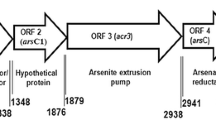Abstract
The ArsA ATPase is the catalytic subunit of the ArsAB oxyanion pump in Escherichia coli that is responsible for extruding arsenite or antimonite from inside the cell, thereby conferring resistance. Either antimonite or arsenite stimulates ArsA ATPase activity. In this study, the role of histidine residues in ArsA activity was investigated. Treatment of ArsA with diethyl pyrocarbonate (DEPC) resulted in complete loss of catalytic activity. The inactivation could be reversed upon subsequent incubation with hydroxylamine, suggesting specific modification of histidine residues. ATP and oxyanions afforded significant protection against DEPC inactivation, indicating that the histidines are located at the active site. ArsA has 13 histidine residues located at position 138, 148, 219, 327, 359, 368, 388, 397, 453, 465, 477, 520, and 558. Each histidine was individually altered to alanine by site-directed mutagenesis. Cells expressing the altered ArsA proteins were resistant to both arsenite and antimonite. The results indicate that no single histidine residue plays a direct role in catalysis, and the inhibition by DEPC may be caused by steric hindrance from the carbethoxy group.
Similar content being viewed by others
REFERENCES
Bhattacharjee, H., Li, J., Ksenzenko, M. Y., and Rosen, B. P. (1995). J. Biol. Chem. 270, 11245–11250.
Bhattacharjee, H., and Rosen, B. P. (1996). J. Biol. Chem. 271, 24465–24470.
Chen, C. M., Misra, T. K., Silver, S., and Rosen, B. P. (1986). J. Biol. Chem. 261, 15030–15038.
Chung, C. T., Niemela, S. L., and Miller, R. H. (1989). Proc. Natl. Acad. Sci. U.S.A. 86, 2172–2175.
Dey, S., Dou, D., and Rosen, B. P. (1994). J. Biol. Chem. 269, 25442–25446.
Drohat, A. C., Jagadeesh, J., Ferguson, E., and Stivers, J. T. (1999). Biochemistry 38, 11866–11875.
Eyzaguirre, J. (1987). Chemical Modification Of Enzymes: Active Site Studies, Halsted Press, New York.
Hedges, R. W., and Baumberg, S. (1973). J. Bacteriol. 115, 459–460.
Hsu, C. M., and Rosen, B. P. (1989). J. Biol. Chem. 264, 17349–17354.
Jia, Y., Kappock, T. J., Frick, T., Sinskey, A. J., and Stubbe, J. (2000). Biochemistry 39, 3927–3936.
Karkaria, C. E., Chen, C. M., and Rosen, B. P. (1990). J. Biol. Chem. 265, 7832–7836.
Kaur, P., and Rosen, B. P. (1992). J. Biol. Chem. 267, 19272–19277.
Lesburg, C. A., Huang, C., Christianson, D. W., and Fierke, C. A. (1997). Biochemistry 36, 15780–15791.
Li, J., and Rosen, B. P. (2000). Mol. Microbiol. 35, 361–367.
Lundblad, R. L. (1995). Techniques in Protein Modification, CRC Press, Florida.
Miles, E. W. (1977). Methods Enzymol. 47, 431–442.
Mobley, H. L., and Rosen, B. P. (1982). Proc. Natl. Acad. Sci. U.S.A. 79, 6119–6122.
Penefsky, H. S. (1977). J. Biol. Chem. 252, 2891–2899.
Quirk, D. J., Park, C., Thompson, J. E., and Raines, R. T. (1998). Biochemistry 37, 17958–17964.
Rosen, B. P., Bhattacharjee, H., Zhou, T., and Walmsley, A. R. (1999). Biochim. Biophys. Acta 1461, 207–215.
Rosen, B. P., Weigel, U., Karkaria, C., and Gangola, P. (1988). J. Biol. Chem. 263, 3067–3070.
Sambrook, J., Fritsch, E. F., and Maniatis, T. (1989). Molecular Cloning, A Laboratory Manual, Cold Spring Harbor Laboratory, New York.
San Francisco, M. J., Hope, C. L., Owolabi, J. B., Tisa, L. S., and Rosen, B. P. (1990). Nucleic Acids Res. 18, 619–624.
Silver, S., Budd, K., Leahy, K. M., Shaw, W. V., Hammond, D., Novick, R. P., Willsky, G. R., Malamy, M. H., and Rosenberg, H. (1981). J. Bacteriol. 146, 983–996.
Tisa, L. S., and Rosen, B. P. (1990). J. Biol. Chem. 265, 190–194.
Vinarov, D. A., and Nowak, T. (1999). Biochemistry 38, 12138–12149.
Vogel, G., and Steinhart, R. (1976). Biochemistry 15, 208–216.
Walker, J. E., Saraste, M., Runswick, M. J., and Gay, N. J. (1982). EMBO J. 1, 945–951.
Walmsley, A. R., Zhou, T., Borges-Walmsley, M. I., and Rosen, B. P. (1999). J. Biol. Chem. 274, 16153–16161.
Wu, J., and Rosen, B. P. (1993). Mol. Microbiol. 8, 615–623.
Zhou, T., Liu, S., and Rosen, B. P. (1995). Biochemistry 34, 13622–13626.
Zhou, T., and Rosen, B. P. (1997). J. Biol. Chem. 272, 19731–19737.
Zhou, T., and Rosen, B. P. (1999). J. Biol. Chem. 274, 13854–13858.
Rights and permissions
About this article
Cite this article
Bhattacharjee, H., Rosen, B.P. Original Research Report: Structure-Function Analysis of the ArsA ATPase: Contribution of Histidine Residues. J Bioenerg Biomembr 33, 459–468 (2001). https://doi.org/10.1023/A:1012818920027
Issue Date:
DOI: https://doi.org/10.1023/A:1012818920027




